
- |<
- <
- 1
- >
- >|
-
Takeshi Yokoyama, Mineyuki Mizuguchi2018 年 41 巻 7 号 p. 979-984
発行日: 2018/07/01
公開日: 2018/07/01
ジャーナル フリー HTMLHereditary transthyretin (TTR)-related amyloidosis is caused by mutations in the TTR gene. The mutations destabilize the tetramer and/or monomer of TTR, and thus the stabilization of TTR is a key strategy for the treatment of TTR-related amyloidosis. In this review, we summarized the natural products and synthetic compounds that have been shown to inhibit the amyloidogenesis of TTR. The stabilizers and/or the amyloid fibril disrupters isolated from natural sources may become lead compounds for the treatment of TTR-related amyloidosis.
 Graphical Abstract Fullsize Image抄録全体を表示PDF形式でダウンロード (2719K) HTML形式で全画面表示
Graphical Abstract Fullsize Image抄録全体を表示PDF形式でダウンロード (2719K) HTML形式で全画面表示 -
Qi Wang, Shudong Liu, Aihua Zhai, Bai Zhang, Guizhen Tian2018 年 41 巻 7 号 p. 985-993
発行日: 2018/07/01
公開日: 2018/07/01
[早期公開] 公開日: 2018/04/28ジャーナル フリー HTMLAMP-activated protein kinase (AMPK) is a metabolic sensor in mammals that is activated when ATP levels in the cell decrease. AMPK is a heterotrimeric protein that comprises 3 subunits, each of which has multiple phosphorylation sites that play critical roles in the regulation of either anabolism or catabolism by directly phosphorylating proteins or modulating gene transcription in multiple pathways, such as synthesis, oxidation and lipolysis of lipid. Research focused on the phosphorylation sites that are involved in lipid metabolism will lead to a better recognition of the role of AMPK in therapeutics for several common diseases. In this review, close attention is paid to the recent research on the structure, and multisite phosphorylation of AMPK subunits, as well as AMPK regulation of lipid metabolism via phosphorylation of related molecules.
 Graphical Abstract Fullsize Image抄録全体を表示PDF形式でダウンロード (1120K) HTML形式で全画面表示
Graphical Abstract Fullsize Image抄録全体を表示PDF形式でダウンロード (1120K) HTML形式で全画面表示
-
Atsushi Takeda2018 年 41 巻 7 号 p. 994
発行日: 2018/07/01
公開日: 2018/07/01
ジャーナル フリー HTMLPDF形式でダウンロード (149K) HTML形式で全画面表示
-
Atsushi Takeda, Haruna Tamano2018 年 41 巻 7 号 p. 995-1000
発行日: 2018/07/01
公開日: 2018/07/01
ジャーナル フリー HTMLThe basal levels of extracellular Zn2+ are in the range of low nanomolar concentrations in the hippocampus and perhaps increase age-dependently. Extracellular Zn2+ dynamics is critical for cognitive activity and excess influx of extracellular Zn2+ into hippocampal neurons is a known cause of cognitive decline. The dentate gyrus is vulnerable to aging in the hippocampus and affected in the early stage of Alzheimer’s disease (AD). The reasons remain unclear. Neurogenesis-related apoptosis may induce non-specific neuronal depolarization by efflux of intracellular K+ in the dentate gyrus and be markedly increased along with aging. Extracellular Zn2+ influx into dentate granule cells via high K+-induced perforant pathway excitation leads to cognitive decline. Modified extracellular Zn2+ dynamics in the dentate gyrus of aged rats is linked with vulnerability to cognitive decline. Amyloid-β1–42 (Aβ1–42) is a causative candidate for AD pathogenesis. When Aβ1–42 concentration reaches picomolar in the extracellular compartment in the dentate gyrus, Zn–Aβ1–42 is formed in the extracellular compartment and rapidly taken up into dentate granule cells, followed by Aβ1–42-induced cognitive decline that is due to Zn2+ released from Aβ1–42, suggesting that dentate granule cells are sensitive to extracellular Zn2+-dependent Aβ1–42 toxicity. This paper deals with proposed vulnerability of the dentate gyrus to aging and Aβ1–42 neurotoxicity.
 Graphical Abstract Fullsize Image抄録全体を表示PDF形式でダウンロード (650K) HTML形式で全画面表示
Graphical Abstract Fullsize Image抄録全体を表示PDF形式でダウンロード (650K) HTML形式で全画面表示 -
Bo Young Choi, Sang Won Suh2018 年 41 巻 7 号 p. 1001-1005
発行日: 2018/07/01
公開日: 2018/07/01
ジャーナル フリー HTMLColchicine or vincristine depolymerize microtubules, an action which blocks neuron axonal transport. Thus, these chemicals showed selective neurotoxicity in hippocampal neurons. However, the mechanism of neurotoxicity by these antimicrotubule agents has remained unclear. Our previous studies have suggested that colchicine-induced hippocampal neuron death is caused by incremental increases in intraneuronal free zinc. We have demonstrated that zinc transporter 3 gene deletion (ZnT3−/−) reduces dentate granule cell death after colchicine injection. This ZnT3−/−-mediated reduction of dentate granule cell death was accompanied by a decrease in the incidence of oxidative injury. Unexpectedly, we found that ZnT3−/− mice contain a higher glutathione (GSH) level in the hippocampal neurons than wild type mice. Thus, ZnT3−/− mice showed less neuronal GSH depletion by colchicine injection, and thus less neuronal death. These results suggest that the higher levels of neuronal GSH in ZnT3−/− mice result in less dentate granule cell death after colchicine injection. In addition to colchicine, our lab also demonstrated that a chemotherapeutic agent, pacritaxel (Taxol), which is a microtubule stabilizing agent, depleted vesicular zinc in the presynaptic terminals and induced a reduction of neurogenesis. Therefore, in the present review, we discussed how antimicrotubule agent-induced neurotoxicity and cognitive impairment is associated with zinc dyshomeostasis in the brain.
 Graphical Abstract Fullsize Image抄録全体を表示PDF形式でダウンロード (853K) HTML形式で全画面表示
Graphical Abstract Fullsize Image抄録全体を表示PDF形式でダウンロード (853K) HTML形式で全画面表示 -
Shinsuke Nakamura, Masamitsu Shimazawa, Hideaki Hara2018 年 41 巻 7 号 p. 1006-1013
発行日: 2018/07/01
公開日: 2018/07/01
ジャーナル フリー HTMLMetallothioneins (MTs) are small-molecular weight metal-binding proteins involved in the maintenance of tissue structure, efficient metal metabolism, and metal detoxification and have an antioxidative effect. Moreover, MTs are expressed as four isoforms, and there are no known patterns in their localization with various effects. According to recent studies, MTs affect central nervous system (CNS) diseases, and many reports suggest that each isoform of MT has a protective effect against disease. Notably, MTs are involved in regions of diseases related to unmet medical needs, and MTs affect intractable neurological diseases, such as amyotrophic lateral sclerosis (ALS) and spinal muscular atrophy (SMA). This review specifically focuses on MT-related ocular diseases, cerebral ischemia, psychological disorders, ALS, and SMA. Each of these diseases has a separate cause, but the conditions are related to MTs. To understand the physiological roles of MTs in CNS diseases, we reviewed the current literature on the complex interactions between each MT, pathological conditions, and perspectives. We also discuss current evidence on the expression and function of MTs for diagnosis and new therapeutic strategies.
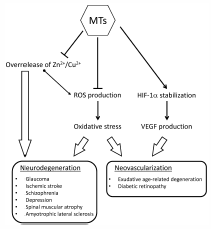 Graphical Abstract Fullsize Image抄録全体を表示PDF形式でダウンロード (2579K) HTML形式で全画面表示
Graphical Abstract Fullsize Image抄録全体を表示PDF形式でダウンロード (2579K) HTML形式で全画面表示
-
Masayuki Saito, Masayoshi Ajioka, Takahiro Iwao, Tadashi Suzuki2018 年 41 巻 7 号 p. 1014-1016
発行日: 2018/07/01
公開日: 2018/07/01
[早期公開] 公開日: 2018/05/11ジャーナル フリー HTMLThe pharmacokinetics and pharmacodynamics of warfarin remained unaffected by tolvaptan during clinical trials. However, tolvaptan prolonged the prothrombin time–international normalized ratio (PT–INR) level of patients with cardiovascular disease taking warfarin. Tolvaptan was prescribed to 576 patients from December 2010 to December 2015. Of these patients, 37 underwent anticoagulant therapy. We investigated PT–INR fluctuation immediately before tolvaptan therapy was initiated. PT–INR remained unchanged in the control group and in groups administered with less than 7.5 mg/d tolvaptan, whereas it was significantly increased (p=0.03) in the group administered with more than 7.5 mg/d tolvaptan. This result indicates the possibility that tolvaptan affects the pharmacodynamics of warfarin in vivo. However, further research is necessary to clarify the mechanism of this phenomenon.
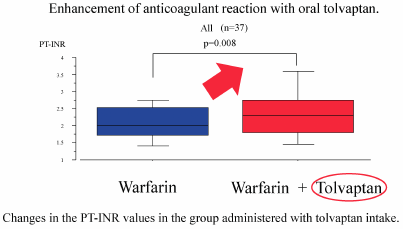 Graphical Abstract Fullsize Image抄録全体を表示PDF形式でダウンロード (281K) HTML形式で全画面表示
Graphical Abstract Fullsize Image抄録全体を表示PDF形式でダウンロード (281K) HTML形式で全画面表示
-
Ryo Iketani, Keiko Ohno, Yohei Kawasaki, Kunihiro Matsumoto, Hiroshi Y ...2018 年 41 巻 7 号 p. 1017-1023
発行日: 2018/07/01
公開日: 2018/07/01
ジャーナル フリー HTML
電子付録Although several studies have evaluated the efficacy of thiazolidinediones (TZD) for the treatment of Alzheimer’s disease (AD), investigation of the impact of apolipoprotein E (ApoE) gene polymorphisms on the efficacy of TZD remains insufficient. We investigated the impact by conducting a systematic review and meta-analysis. MEDLINE, Cochrane Library, and Japana Centra Revuo Medicina were searched to identify relevant studies based on eligibility criteria. Mean differences (MD) of Alzheimer’s Disease Assessment Scale-cognitive subscale (ADAS-Cog) total score with 95% confidence intervals (CI) were calculated for subgroups stratified by ApoE genotype. To evaluate the impact of ApoE gene polymorphisms, meta-regression analysis was also conducted to calculate the regression coefficient (Coef) of ApoE expression status with 95% CI. Three randomized controlled studies comparing rosiglitazone and placebo, with a total of 2381 subjects met the eligibility criteria. ApoE expression status was reported in 983 individuals (ApoE4-positive, 141; ApoE4-negative, 842). When compared to placebo, rosiglitazone significantly decreased ADAS-Cog score in ApoE4-negative individuals (MD, −1.37; 95% CI, −2.09 to −0.65), but significantly increased ADAS-Cog score in ApoE4-positive individuals (MD, 2.18; 95% CI, 0.52 to 3.85). The meta-regression analysis showed a significant association between efficacy and ApoE expression status (Coef, 3.55; 95% CI, 1.42 to 5.68). Although the present results should be interpreted with caution because of the limited number of studies, our findings suggest that ApoE gene polymorphisms impact the efficacy of rosiglitazone for AD patients. This finding would provide useful information for the development of new agents for AD.
 Graphical Abstract Fullsize Image抄録全体を表示PDF形式でダウンロード (961K) HTML形式で全画面表示
Graphical Abstract Fullsize Image抄録全体を表示PDF形式でダウンロード (961K) HTML形式で全画面表示 -
Guo-dong Xu, Lei Cai, Yi-shu Ni, Shi-yi Tian, Ying-qi Lu, Li-na Wang, ...2018 年 41 巻 7 号 p. 1024-1033
発行日: 2018/07/01
公開日: 2018/07/01
ジャーナル フリー HTML
電子付録Acarbose and voglibose are the most widely used diabetes drugs as glycosidase inhibitors. In this study, the use of these two inhibitors significantly increased the content of starch in large intestine, and altered the concentration of short-chain fatty acids (SCFAs) by affecting the intestinal microbiota. However, there are some differences in the intestinal microbiome of the two groups of mice, mainly in bacteria such as Bacteroidaceae bacteroides and Desulfovibrionaceae desulfovibrio. The productions of acetate and propionate in caecum in voglibose group were significantly higher than those in acarbose group and two kinds of glycosidase inhibitors were close in the production of butyrate in caecum. The Tax4Fun analysis based on Kyoto Encyclopedia of Genes and Genomes (KEGG) data indicated that different productions of acetate and propionate between acarbose group and voglibose group may be related to 2-oxoisovalerate dehydrogenase and pyruvate oxidase. In addition, in-vitro experiments suggested that voglibose had less effect on epithelial cells than acarbose after direct stimulation. According to the recent researches of SCFAs produced by intestinal microbiota, our comparative study shown higher concentration of these beneficial fatty acids in the lumen of voglibose-treated mice, which implied a lower level of inflammation.
 Graphical Abstract Fullsize Image抄録全体を表示PDF形式でダウンロード (942K) HTML形式で全画面表示
Graphical Abstract Fullsize Image抄録全体を表示PDF形式でダウンロード (942K) HTML形式で全画面表示 -
Yohei Hotta, Ryoji Fujino, Osamu Kimura, Tetsuya Endo2018 年 41 巻 7 号 p. 1034-1039
発行日: 2018/07/01
公開日: 2018/07/01
ジャーナル フリー HTML
電子付録Essential elements (Ca, Mg, Zn, Cu, Fe, Cr, Mn and V) and non-essential elements (As, Cd, Hg and Pb) were measured in scalp hair samples of 45 diabetic subjects and 59 control subjects in Japan using inductively coupled plasma mass spectrometry. All diabetic subjects took insulin and/or antidiabetic agents, with glycated hemoglobin (HbA1c) ranging between 6.2 and 14.4%. The levels of Zn, Cu and Cr in the diabetic subjects (HbA1c>7) were significantly lower than those in the control subjects (p<0.05), and these concentrations decreased significantly with increases in HbA1c (p<0.01). The levels of Fe and Mg in the diabetic subjects were insignificantly lower, and the concentration of Fe decreased significantly with increases in HbA1c (p<0.05) and the concentration of Mn tended to decrease (p<0.10). In contrast, the concentration of As tended to increase with increases in HbA1c (p<0.10). The concentrations of other elements, such as Ca, Mn, V, Pb, Cd and Hg, in the diabetic subjects were similar to those of control subjects, and did not correlate with HbA1c. The average of estimated glomerular filtration rate (eGFR) in the diabetic subjects was 77.7±29.7 mL/min/1.73 m2 with large variation (12.7–148 mL/min/1.73 m2), and previous study reported the increase of urinary excretion of Zn, Cr, Mn and Mg in diabetic subjects. The decreases of Zn, Cu, Cr, Fe and Mg concentrations in hair may reflect increased urinary excretion of these elements due to diabetic nephropathy.
 Graphical Abstract Fullsize Image抄録全体を表示PDF形式でダウンロード (496K) HTML形式で全画面表示
Graphical Abstract Fullsize Image抄録全体を表示PDF形式でダウンロード (496K) HTML形式で全画面表示 -
Min Liang, Yuru Du, Wenjing Li, Xi Yin, Ni Yang, Anran Qie, Tyler W. L ...2018 年 41 巻 7 号 p. 1040-1048
発行日: 2018/07/01
公開日: 2018/07/01
[早期公開] 公開日: 2018/05/09ジャーナル フリー HTMLSuHeXiang (SHX) has been used to treat a wide range of diseases, including those related to the central nervous system. However, the effects of SHX on mood disorders are still elusive. This study aimed to investigate the effects of SHX essential oil on stress-induced depression of mice. In an acute stress-induced depression model, mice inhaled vehicle (1% Tween 80) for 10 min or 10% SHX for 10 or 30 min once daily for 12 continuous days. In the chronic mild stress (CMS)-induced depression model, mice were exposed to a 28-d CMS treatment. Tail suspension test (TST), forced swimming test (FST), sucrose preference test (SPT), open field test (OFT), and novelty suppressed feeding (NSF) test were conducted. In addition, serum levels of angiogenin (ANG), thrombopoietin (TPO), interleukin 6 (IL-6), and tumor necrosis factor-α (TNF-α) were evaluated by enzyme-linked immunosorbent assay (ELISA) assays. The results showed that in mice exposed to acute stress, repeated SHX inhalation exerted significant antidepressant and anxiolytic activities, and also reduced the serum levels of ANG, TPO, IL-6, and TNF-α. It also significantly reversed the depressive and anxiety-like behaviors, and reduced the serum levels of ANG and TPO in mice exposed to CMS. This is the first report to show that SHX inhalation could produce significant antidepressant and anxiolytic-like effects. These effects might be mediated by SHX ability to modulate the inflammatory response, and reduce dysfunction of vascular genesis and thrombosis. These results support further exploration for developing SHX inhalation as a novel therapeutic strategy for depression and stress-related disorders.
 Graphical Abstract Fullsize Image抄録全体を表示PDF形式でダウンロード (1527K) HTML形式で全画面表示
Graphical Abstract Fullsize Image抄録全体を表示PDF形式でダウンロード (1527K) HTML形式で全画面表示 -
Chikako Shimizu, Yutaka Mitani, Youichi Tsuchiya, Toshitaka Nabeshima2018 年 41 巻 7 号 p. 1049-1061
発行日: 2018/07/01
公開日: 2018/07/01
[早期公開] 公開日: 2018/05/16ジャーナル フリー HTMLEthanol (EtOH) dosage, frequency, and paired associative learning affect the risk of alcoholism. Recently, Spanagel et al. reported that acamprosate calcium (Acam Ca) prescribed for alcoholism exerts an anti-relapse effect via Ca. Ca is contained in foods, sometimes consumed with alcohol. Therefore, we investigated the association among oral Ca ingestion, EtOH-induced locomotor sensitization, and plasma Ca levels on how to consume Ca for moderate drinking. We used DBA/2 CrSlc mice, and CaCl2 as water-soluble Ca salts. For pre-administration, elemental Ca (50, 75, 100, or 150 mg/kg, per os (p.o.)) or water for control was administered 1 h before EtOH (2 g/kg, 20 v/v (%) EtOH in saline) administration intraperitoneal (i.p.) for locomotor sensitization or for plasma Ca level changes. For post-administration, elemental Ca (100 mg/kg) was administered 1 h after EtOH. Moreover, we employed bepridil and the dopamine D1 antagonist, SCH-23390 to further examine the mechanism of EtOH-induced sensitization. The locomotor sensitization segmentalized for 300 s had two peaks (0–90 s and 180–300 s). Pre-administration of Ca (50, 75, and 100 mg/kg) significantly reduced the 0–90-s peak, selectively blocked by SCH-23390, but “non-dose dependently” as Ca 150 mg/kg did not have this effect. Bepridil blocked the suppressive effect of pre-administration of Ca (100 mg/kg). The effective pre-doses of Ca (50–100 mg/kg) maintained plasma Ca basal levels against EtOH-induced decrease of Ca. On the contrary, post-administration of Ca inversely led to significant promotion of sensitization of both locomotor peaks. Oral Ca intake had diverse effects on EtOH-induced sensitization depending on Ca dosage and timing.
 Graphical Abstract Fullsize Image抄録全体を表示PDF形式でダウンロード (1294K) HTML形式で全画面表示
Graphical Abstract Fullsize Image抄録全体を表示PDF形式でダウンロード (1294K) HTML形式で全画面表示 -
Yuki Kiguchi, Hiroyuki Oyama, Izumi Morita, Emiko Katayama, Masatoshi ...2018 年 41 巻 7 号 p. 1062-1070
発行日: 2018/07/01
公開日: 2018/07/01
ジャーナル フリー HTMLAntibodies are essential for characterizing various analytes. “Molecular-breeding” approaches enable rapid generation of antibody mutants with desirable antigen-binding abilities. Typically, prototype antibodies are converted to single-chain Fv fragments (scFvs), and random mutations are genetically introduced to construct molecular libraries with a vast diversity. Improved species therein are then isolated via phage display genotype−phenotype-connecting systems to separate them from a large excess of nonspecific scFvs. During these experiments, counting of phage particles is routinely performed. However, current methods depend on the time-consuming overnight cultivation of phage-infected bacteria on agar plates to estimate phage numbers as plaque-forming units (pfu) or colony-forming units, the results of which fluctuate considerably. Immunochemical systems capturing phage particles should be a more convenient and robust alternative. We therefore generated monoclonal antibodies against M13 filamentous phage, which is commonly used for phage display, by employing hybridoma technology. Combinatorial use of two such antibodies (Ab-M13#53 and #71; both specific to the major coat protein pVIII) enabled development of a sandwich enzyme-linked immunosorbent assay (ELISA) that could measure ca. 107−1010 phage pfu/mL. To construct a more convenient system, Ab-M13#71 was converted to the scFv form and further fused with an alkaline phosphatase variant. Using this fusion protein, the sandwich ELISA enabled rapid (within 90 min) and reliable phage counting without reducing the sensitivity, and the results were reasonably consistent with those of infection-based methods. The present anti-phage antibodies and scFvs might also enable visualization of individual phage particles by combining them with sensitive fluorescent staining.
 Graphical Abstract Fullsize Image抄録全体を表示PDF形式でダウンロード (1185K) HTML形式で全画面表示
Graphical Abstract Fullsize Image抄録全体を表示PDF形式でダウンロード (1185K) HTML形式で全画面表示 -
Conversion of Curcumin into Heterocyclic Compounds as Potent Anti-diabetic and Anti-histamine AgentsSara Nabil, Soheir N. Abd El-Rahman, Suhailah S. Al-Jameel, Asma M. El ...2018 年 41 巻 7 号 p. 1071-1077
発行日: 2018/07/01
公開日: 2018/07/01
[早期公開] 公開日: 2018/04/12ジャーナル フリー HTMLPotential biologically active derivatives of the curcumin were prepared by the cyclocondensation reaction cyclohexanone 2, imino pyrimidine 3, pyrmidinones 4, thiopyrimidine 6 and pyranone 5, 7 when treated with acetylacetone, guanidine, ureaethylcyanoacetate, thiourea and ethylacetoacetate, respectively. The structures of compounds (2–7) were elucidated by means of microanalysis as well as spectral measurements such as IR, 1H-NMR, MS. The anti-diabetic potential of curcumin derivatives were evaluated by assessing amylase inhibition assay, also inhibition of histamine release activity of curcumin derivatives were assessed by U937 human monocytes. The results for amylase inhibition activity revels that the curcumin inhibits α-amylase in a concentration dependent manner. Compounds 4 and 5 exhibited significant inhibitory activity against amylase enzyme and was comparable with that of acrabose. Also, compounds 5, 6 and 7 exhibited significant inhibitory activity against histamine. Our results concluded that curcumin pyrmidinones and pyranone derivatives have highly effects as anti-diabetic and anti-histamine activities.
 Graphical Abstract Fullsize Image抄録全体を表示PDF形式でダウンロード (790K) HTML形式で全画面表示
Graphical Abstract Fullsize Image抄録全体を表示PDF形式でダウンロード (790K) HTML形式で全画面表示 -
 Sherif E. Emam, Hidenori Ando, Amr Selim Abu Lila, Shinya Kobayashi, T ...2018 年 41 巻 7 号 p. 1078-1083
Sherif E. Emam, Hidenori Ando, Amr Selim Abu Lila, Shinya Kobayashi, T ...2018 年 41 巻 7 号 p. 1078-1083
発行日: 2018/07/01
公開日: 2018/07/01
ジャーナル フリー HTMLModulation of tumor immunity is a known factor in the antitumor activity of many chemotherapeutic agents. Exosomes are extracellular nanometric vesicles that are released by almost all types of cells, which includes cancer cells. These vesicles play a crucial role in tumor immunity. Many in vitro studies have reproduced the aggressive secretion of exosomes following treatment with conventional anticancer drugs. Nevertheless, how chemotherapeutic agents including nanomedicines such as Doxil® affect the in vivo secretion of exosomes is yet to be elucidated. In this study, the effect of intravenous injection of either free doxorubicin (DXR) or liposomal DXR formulation (Doxil®) on exosome secretion was evaluated in BALB/c mice. Exosomes were isolated from serum by using an ExoQuick™ kit. Free DXR treatment markedly increased serum exosome levels in a post-injection time-dependent manner, while Doxil® treatment did not. Exosomal size distribution and marker protein expressions (CD9, CD63, and TSG101) were studied. The physical/biological characteristics of treatment-induced exosomes were comparable to those of control mice. Interestingly, splenectomy significantly suppressed the copious exosomal secretions induced by free DXR. Collectively, our results indicate that conventional anticancer agents induce the secretion of circulating exosomes, presumably via stimulating immune cells of the spleen. As far as we know, this study represents the first report indicating that conventional chemotherapeutics may induce exosome secretion which might, in turn, contribute partly to the antitumor effect of chemotherapeutic agents.
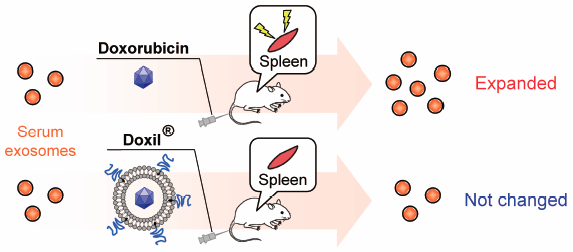 Graphical Abstract Fullsize Image抄録全体を表示Editor's pick
Graphical Abstract Fullsize Image抄録全体を表示Editor's pickExosomes are extracellular vesicles released by various types of cells, including immune cells and cancer cells. The article by Emam et al evaluated in vivo secretion of exosomes following intravenous injection of free doxorubicin (DXR) or liposomal DXR (Doxil®) was evaluated using normal mice. Free DXR treatment markedly increased the serum exosome level, while Doxil® treatment did not change. Interestingly, splenectomy significantly suppressed the exosomal secretions induced by free DXR treatment. Their results suggest that conventional anticancer agents induce the secretion of exosomes via stimulating immune cells of the spleen, and might contribute to the antitumor effect of chemotherapeutic agents.
PDF形式でダウンロード (553K) HTML形式で全画面表示 -
Tong Zhang, Satoshi Deyama, Masaki Domoto, Shintaro Wada, Junko Yanagi ...2018 年 41 巻 7 号 p. 1084-1088
発行日: 2018/07/01
公開日: 2018/07/01
ジャーナル フリー HTMLCocaine-associated environmental cues elicit craving and relapse to cocaine use by recalling the rewarding memory of cocaine. However, the neuronal mechanisms underlying the expression of cocaine-associated memory are not fully understood. Here, we investigated the possible contribution of γ-aminobutyrate (GABA)ergic neurons in the nucleus accumbens (NAc), a key brain region associated with the rewarding and reinforcing effects of cocaine, to the expression of cocaine-associated memory using the conditioned place preference (CPP) paradigm combined with designer receptors exclusively activated by designer drugs (DREADD) technology. The inhibitory DREADD hM4Di was selectively expressed in NAc GABAergic neurons of vesicular GABA transporter-Cre (vGAT-Cre) mice by infusing adeno-associated virus (AAV) vectors. Ex vivo electrophysiological recordings revealed that bath application of clozapine-N-oxide (CNO) significantly hyperpolarized membrane potentials and reduced the number of spikes induced by depolarizing current injections in hM4Di-positive NAc neurons. Additionally, systemic CNO injections into cocaine-conditioned mice 30 min before posttest session significantly reduced CPP scores compared to saline-injected mice. These results indicate that chemogenetic inhibition of NAc GABAergic neurons attenuated the expression of cocaine CPP, suggesting that NAc GABAergic neuronal activation is required for the environmental context-induced expression of cocaine-associated memory.
 Graphical Abstract Fullsize Image抄録全体を表示PDF形式でダウンロード (830K) HTML形式で全画面表示
Graphical Abstract Fullsize Image抄録全体を表示PDF形式でダウンロード (830K) HTML形式で全画面表示 -
Tomohito Tsukamoto, Eiko Sakai, Shunsuke Iizuka, Marcos Taracena-Gánda ...2018 年 41 巻 7 号 p. 1089-1095
発行日: 2018/07/01
公開日: 2018/07/01
ジャーナル フリー HTML
電子付録The clustered regularly interspaced short palindromic repeats (CRISPR)/CRISPR-associated protein (Cas) 9 system is now widely used as a genome editing tool. CRISPR-associated endonuclease in Prevotella and Francisella 1 (Cpf1) is a recently discovered Cas endonuclease that is designable and highly specific with efficiencies comparable to those of Cas9. Here we generated the adenovirus (Ad) vector carrying an Acidaminococcus sp. Cpf1 (AsCpf1) expression cassette (Ad-AsCpf1) for the first time. Ad-AsCpf1 was applied to primary human hepatocytes prepared from humanized mice with chimeric liver in combination with the Ad vector expressing the guide RNA (gRNA) directed to the Adeno-associated virus integration site 1 (AAVS1) region. The mutation rates were estimated by T7 endonuclease I assay around 12% of insertion/deletion (indel). Furthermore, the transduced human hepatocytes were viable (ca. 60%) at two weeks post transduction. These observations suggest that the Ad vector-mediated delivery of the CRISPR/AsCpf1 system provides a useful tool for genome manipulation of human hepatocytes.
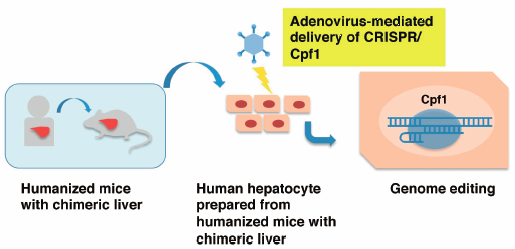 Graphical Abstract Fullsize Image抄録全体を表示PDF形式でダウンロード (2914K) HTML形式で全画面表示
Graphical Abstract Fullsize Image抄録全体を表示PDF形式でダウンロード (2914K) HTML形式で全画面表示 -
Temporal Kinetics of Microgliosis in the Spinal Dorsal Horn after Peripheral Nerve Injury in RodentsKeita Kohno, Junko Kitano, Yuta Kohro, Hidetoshi Tozaki-Saitoh, Kazuhi ...2018 年 41 巻 7 号 p. 1096-1102
発行日: 2018/07/01
公開日: 2018/07/01
ジャーナル フリー HTMLNeuropathic pain, a highly debilitating chronic pain following nerve damage, is a reflection of the aberrant functioning of a pathologically altered nervous system. Previous studies have implicated activated microglia in the spinal dorsal horn (SDH) as key cellular intermediaries in neuropathic pain. Microgliosis is among the dramatic cellular alterations that occur in the SDH in models of neuropathic pain established by peripheral nerve injury (PNI), but detailed characterization of SDH microgliosis has yet to be realized. In the present study, we performed a short-pulse labeling of proliferating cells with ethynyldeoxyuridine (EdU), a marker of the cell cycle S-phase, and found that EdU+ microglia in the SDH were rarely observed 32 h after PNI, but rapidly increased to the peak level at 40 h post-PNI. Numerous EdU+ microglia persisted for the next 20 h (60 h post-PNI) and decreased to the baseline on day 7. These results demonstrate a narrow time window for rapidly inducing a proliferation burst of SDH microglia after PNI, and these temporally restricted kinetics of microglial proliferation may help identify the molecule that causes microglial activation in the SDH, which is crucial for understanding and managing neuropathic pain.
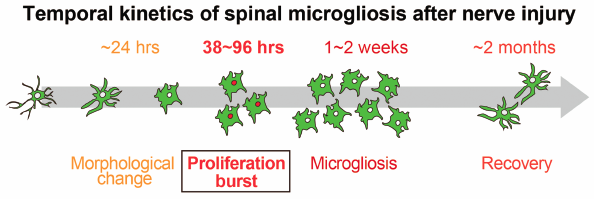 Graphical Abstract Fullsize Image抄録全体を表示PDF形式でダウンロード (10301K) HTML形式で全画面表示
Graphical Abstract Fullsize Image抄録全体を表示PDF形式でダウンロード (10301K) HTML形式で全画面表示
-
Jantana Yahuafai, Tomohiro Asai, Naoto Oku, Pongpun Siripong2018 年 41 巻 7 号 p. 1103-1106
発行日: 2018/07/01
公開日: 2018/07/01
ジャーナル フリー HTMLBerberine, the main isoquinoline alkaloid obtained from traditional plants, e.g., Berberis, Coptis, Coscinium spps., etc., is known to exhibit anticancer activity in vitro and in vivo. In this study, the anticancer potential of berberine combined with PEGylated liposomal doxorubicin (polyethylene glycol (PEG)-lip-DOX) was investigated. At first, the effect of berberine on endothelial cells was examined in vitro by use of human umbilical vein endothelial cells (HUVECs): Berberine inhibited HUVEC growth with an IC50 at 24 h of about 144 µg/mL and that at 72 h of about 29 µg/mL. In contrast, less than 50 µg/mL berberine inhibited the vascular endothelial growth factor (VEGF) expression to some extent after a 24-h incubation, suggesting that berberine suppressed angiogenic action under the condition of little cytotoxicity. Next, the in vivo anticancer activity of the combination of berberine (intraperitoneally (i.p.)) and PEG-lip-DOX (intravenously (i.v.)) was examined in Meth A sarcoma-transplanted BALB/c mice. The results showed that either berberine or PEG-lip-DOX exhibited antiproliferative activity against Meth A cells. Moreover, treatment with the combination of berberine and PEG-lip-DOX suppressed the tumor growth more strongly than that with berberine or PEG-lip-DOX alone. Based on these findings, the combination cancer chemotherapy with berberine and PEGylated liposomal doxorubicin may be beneficial for the treatment of cancer.
 Graphical Abstract Fullsize Image抄録全体を表示PDF形式でダウンロード (451K) HTML形式で全画面表示
Graphical Abstract Fullsize Image抄録全体を表示PDF形式でダウンロード (451K) HTML形式で全画面表示 -
Yoichi Negishi, Nobuhito Hamano, Hinako Sato, Fumihiko Katagiri, Kyohe ...2018 年 41 巻 7 号 p. 1107-1111
発行日: 2018/07/01
公開日: 2018/07/01
ジャーナル フリー HTMLLiposomes have been used as targeting carriers for drug delivery systems (DDSs), and the carriers are able to be modified with targeting ligands, such as antibodies and peptides. To evaluate the targetability of DDS carriers modified with a targeting ligand, culture cells expressing the targeting molecules as well as small animals are used. Furthermore, in vitro and in vivo screening analyses must be repeatedly performed. Therefore, it is important to establish an easy and high-precision screening system for targeting carriers. With this aim, we focused that whether this ex vivo system could easily support assessment of interaction between targeting ligand and its receptor under physiological environment and further screen the DDS carrier-modified with targeting moiety. We examined targeting ability via in vitro, ex vivo, and in vivo analyses using integrin αvβ3-targeting C16Y-L. For the in vitro analysis, the cellular uptake of C16Y-L was higher than that of control liposomes in colon26 cells. For the ex vivo analysis, we performed an immunohistochemical analysis using colon26 tumor sections. C16Y-L was specifically attached to the tumor sections, as found in the in vitro analysis. Moreover, to evaluate the ex vivo–in vivo correlation, we examined the intratumoral localization of C16Y-L. This result showed that C16Y-L was accumulated not only in the tumor tissue but also in the tumor vasculature after the intravenous injection of C16Y-L, suggesting that the ex vivo peptide-modified liposomal analysis was correlated with the in vivo analysis. Thus, the ex vivo peptide-modified liposomal analysis may be an easy and rapid screening system with high-precision and for consideration in in vivo conditions.
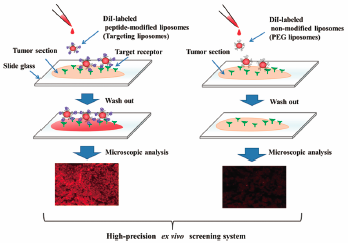 Graphical Abstract Fullsize Image抄録全体を表示PDF形式でダウンロード (1233K) HTML形式で全画面表示
Graphical Abstract Fullsize Image抄録全体を表示PDF形式でダウンロード (1233K) HTML形式で全画面表示 -
Takehiro Yamada, Shungo Imai, Yasuyuki Koshizuka, Yuki Tazawa, Keisuke ...2018 年 41 巻 7 号 p. 1112-1118
発行日: 2018/07/01
公開日: 2018/07/01
[早期公開] 公開日: 2018/05/11ジャーナル フリー HTMLTherapeutic drug monitoring for voriconazole, an antifungal agent, is essential for maximizing efficacy and preventing toxicity. The aim of this study was to elucidate the optimal maintenance dose of voriconazole in patients with severe liver cirrhosis (Child–Pugh class C) by reviewing the plasma trough concentrations obtained by therapeutic drug monitoring and daily doses of voriconazole. We retrospectively evaluated 6 patients with Child–Pugh class C cirrhosis who received oral voriconazole treatment and were liver transplant recipients or were awaiting liver transplantation. We compared their voriconazole trough concentrations and daily maintenance doses to those of patients who did not have liver cirrhosis (n=56). We found that plasma voriconazole trough concentrations in all patients with Child–Pugh class C were almost within therapeutic range, and the median plasma trough concentration at steady state was not significantly different from that of patients who did not have liver cirrhosis. In addition, the median daily maintenance dose of voriconazole was significantly lower (2.13 mg/kg/d) than that of the control patients (6.27 mg/kg/d), suggesting that trough voriconazole concentrations are elevated in Child–Pugh class C patients. Thus, we conclude that oral voriconazole maintenance doses in patients with Child–Pugh class C should be reduced to approximately one-third that of patients with normal liver function, with the follow-up dose adjusted by therapeutic drug monitoring.
 Graphical Abstract Fullsize Image抄録全体を表示PDF形式でダウンロード (572K) HTML形式で全画面表示
Graphical Abstract Fullsize Image抄録全体を表示PDF形式でダウンロード (572K) HTML形式で全画面表示
- |<
- <
- 1
- >
- >|